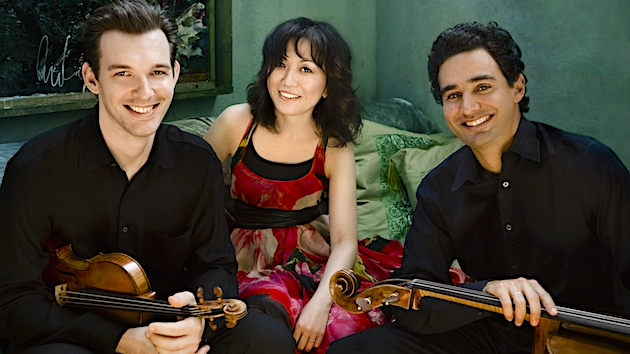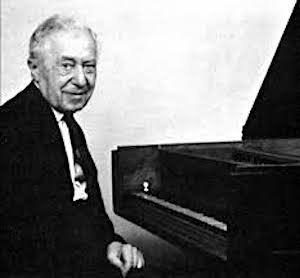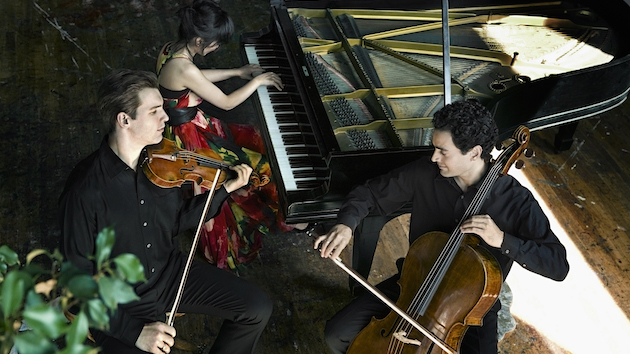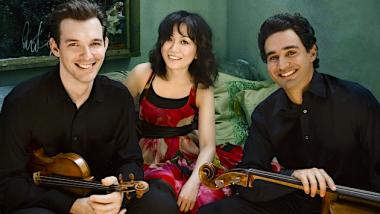
Standing before a stained-glass window capturing the heavens, violinist Jesse Mills oriented the audience, fittingly, to something bigger. He introduced Shostakovich’s Piano Trio No. 2 in E Minor, Op. 67. It was the final work in an engrossing concert at Noe Valley Ministry by the Horszowski Trio, also including pianist Rieko Aizawa and cellist Raman Ramakrishnan. Many know Shostakovich composed the trio upon the death of his friend Ivan Sollertinsky in 1944. Mills, however, mentioned only the wider context: World War II and the horrific news of Nazi concentration camps that Shostakovich, like many, was just perceiving.
The evening capped the trio’s residency with Noe Valley Chamber Music. Previous performances that weekend included salon and children’s concerts. The latter encouraged young listeners to lay on the floor and color. Our call to action Sunday afternoon was different.
“There are some visceral, powerful sections bordering on the ugly at times,” Mills said of the Shostakovich. Then he added that its context is vital for us to ponder especially against today’s landscape.
To whichever specific modern cruelties Mills referred remained unclear. But when the players began the first movement, Ramakrishnan bowing a cold, frail, caterwauling melody on high harmonics, everything present seemed to fade away anyway. By the time Aizawa entered with low, leaden octaves, we were unmistakably deep in a wartime work; the ensemble evoked the more haunting passages with arresting, assertive detail.

The New York City-based Horszowski Trio, named for the late pianist Mieczysław Horszowski (under whom Aizawa studied as his last student) is known for playing with conviction. Their performance here, ruled by pointed attention to emotional shading, was bold and ardent. Especially in the Allegro con brio, the strings whipped up a gritty, at times blistering intensity; the trio charged into the brisk scherzo, as if to highlight its irony in this context. This vibe resurfaced with gnashing verve in the last movement. There, a klezmer tune warps into desperation — the clearest gesture to the tragic subject matter.
Throughout the Shostakovich, the players frequently darted between beauty and ire. The overall program showed off the Horszowskis’ penchant for deft, quicksilver transitions. The concert opened with Schumann’s Piano Trio No. 1 in D Minor, Op. 63. Selections from Elliott Carter’s Epigrams, his last work, written at age 103, followed. Throughout, their sound filled the hall well. Listeners showed signs of rapt engagement, from forward leans to audible sighs, especially at the Shostakovich’s close.
Schumann’s complete trios are the focus of the Horszowskis’ latest album and, indeed, the Op. 63 felt lived in. The first movement, while feeling at first like it might run away, had a supple flow as the theme developed. Mills expressed the melody with a hearty, burnished tone. Matching articulation between Mills and Ramakrishnan, especially in the second movement during their synchronized upward-skipping dotted rhythm, was particularly pleasing.

The trio members displayed playful personality in the Carter, which, as Mills noted, already brims with character. They’re short vignettes full of twists and turns, meant to be brief and witty. The trio selected five of the 12 Epigrams: V, VII, VIII, XI, and XII. They believed this selection showed Carter’s “mastery of texture,” Mills said. Aizawa, a steady force, displayed delightful charisma here in delicate utterances or coy leapfrogging onto the backs of the strings’ phrases. Carter culled from a different soundscape than Schumann and Shostakovich; VII alone required a vivid pizzicato palate spanning full-bodied strums to piquant pops. Because it was also a chance to show off the trio’s deep communication, the contemporary work felt right at home mid-program.
In introducing the Carter, Mills mused that the silences are as crucial as the notes themselves. But in the Horszowskis’s hands, which added startling stabs of color with impeccable attention to timing, audience reactions proved just as entertaining, too.




